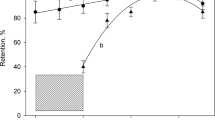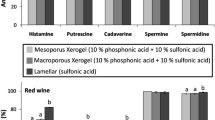Abstract
IN the estimation of silica by the colorimetric method of Diénert and Wandenbulcke1, the yellow colour produced by the addition of ammonium molybdate in acid solution has hitherto been attributed to the ions of a heteropolyacid. The fact, easy to establish, that silica sols do not, under these conditions, give an intensity of colour proportional to the silica present, has led to the belief that colloid micellae of silica do not give the reaction, and that the colour intensity is proportional to the crystalloid silica. We believe this view to be incorrect.
This is a preview of subscription content, access via your institution
Access options
Subscribe to this journal
Receive 51 print issues and online access
$199.00 per year
only $3.90 per issue
Buy this article
- Purchase on Springer Link
- Instant access to full article PDF
Prices may be subject to local taxes which are calculated during checkout
Similar content being viewed by others
References
C.R. Acad. Sci., 176, 1487 (1923).
Ind. Eng. Chem., Anal. Ed., 6, 384 (1934).
Z. anorg. Chem., 201, 361 (1931).
Author information
Authors and Affiliations
Rights and permissions
About this article
Cite this article
TOURKY, A., BANGHAM, D. Colloidal Silica in Natural Waters and the Silicomolybdate Colour Test. Nature 138, 587–588 (1936). https://doi.org/10.1038/138587c0
Issue Date:
DOI: https://doi.org/10.1038/138587c0
This article is cited by
-
Rapid microdetermination of silicon in rice plant
Plant and Soil (1975)
Comments
By submitting a comment you agree to abide by our Terms and Community Guidelines. If you find something abusive or that does not comply with our terms or guidelines please flag it as inappropriate.



